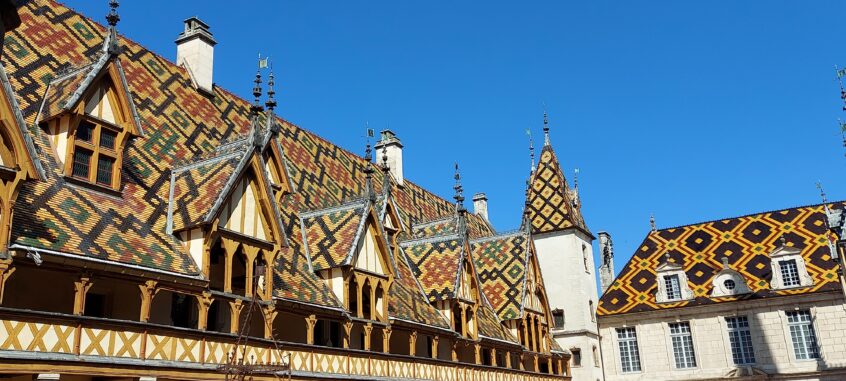I will have to return and spend a few days in Beaune. It is one of the loveliest places we visited, right in the heart of Burgundy. The town is best known for Hotel – Dieu, Des Hospices Civils. The hospital was founded in 1443 by wealthy locals, Nicolas Rolin and his wife Guigone, as a way of helping the poor in the area. Until 1980 it functioned as a hospital or nursing care facility, run by the Catholic church. But that’s not why it’s famous—the architecture and medieval art there are extraordinary.
I had no idea what to expect, so walking through the entrance to the inner courtyard took away my breath. The tiled roof is enormous and gorgeous. The turrets and towers are equally impressive. The hospital is now a museum, with the rooms restored to what they would have looked like hundreds of years ago. Our guide pointed out that since most peasants couldn’t read the paintings were meant to convey bible stories. The main story, repeated over and over, is judgment day. The church wanted everyone to repent.
I could have spent a long time looking at the artwork but the town of Beaune beckoned. It’s known for food and wine and every other shop appeared to be a charcuterie, boulangerie, patisserie, wine cellar, bar, or restaurant. I eyed everything but didn’t have time to sample much of anything. There was also a small open-air market right outside the hospital museum. Unfortunately, the bus was returning to the boat, so I bid adieu and swore to myself I’d return.
In the afternoon I joined an excursion to Chateau de Chamirey in the teensy town of Mercurey. The tasting building is very modern, the view timeless. I was more impressed with the surroundings than the wine. Our guide was an American who’d been living in the area for over thirty years. Her explanations helped me understand the very specific and (to me) peculiar laws and traditions of Burgundy wine producers. All vines are on slopes since no irrigation is permitted. On flat terrain farmers grow wheat, corn for livestock, sunflowers, and rapeseed (for oil).
Back in Chalon Sur Saone (where the boat is docked) I saw the statue of Nicephore Niepce, the inventor of photography. The town is proud of this and has a photography museum. The guide explained his history and how he died penniless, while Louis Daguerre got the credit for his work. That seems to be a recurring theme as I travel the world.
Tonight, is our last night on the boat, tomorrow — Paris.

